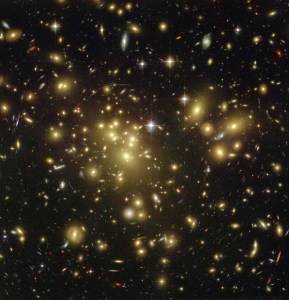
Hubble Images Galaxy Cluster Abell 1689
Hubble's Advanced Camera for Surveys (ACS) took this unprecedented image of the cosmos. Hubble peered straight through the center of one of the most massive galaxy clusters known, called Abell 1689. The gravity of the cluster's trillion stars - plus dark matter - acts as a 2-million-light-year-wide "lens" in space. This "gravitational lens" bends and magnifies the light of the galaxies located far behind it. Some of the faintest objects in the picture are probably over 13 billion light-years away (redshift value 6). Though gravitational lensing has been studied previously by Hubble and ground-based telescopes, this phenomenon has never been seen before in such detail. The ACS picture reveals 10 times more arcs than would be seen by a ground-based telescope. The ACS is 5 times more sensitive and provides pictures that are twice as sharp as the previous work-horse Hubble cameras. So it can see the very faintest arcs with greater clarity. The picture presents an immense jigsaw puzzle for Hubble astronomers to spend months untangling. Interspersed with the foreground cluster are thousands of galaxies, which are lensed images of the galaxies in the background universe. Detailed analysis of the images promises to shed light on galaxy evolution, the curvature of space, and the mystery of dark matter. The picture is an exquisite demonstration of Albert Einstein's prediction that gravity warps space and distorts beams of light. This representative color image is a composite of visible-light and near-infrared exposures taken in June 2002.
- X



























